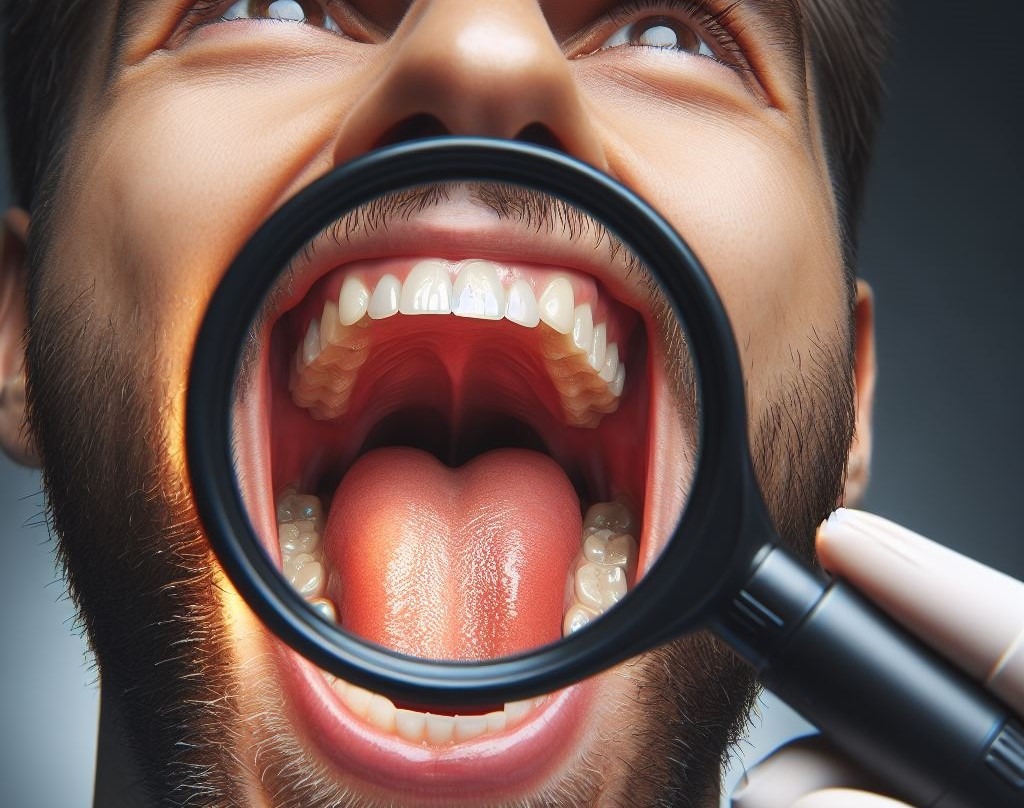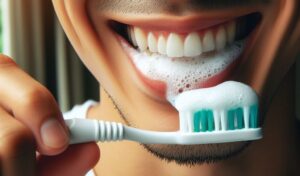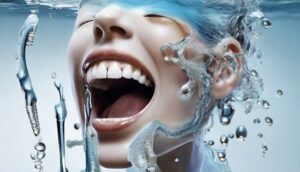You might have heard that yellowing on the roof of mouth is just a harmless condition, but let me tell you, it could signify underlying issues that need attention.
The roof of your mouth might appear pale or yellow for a variety of reasons, including bad oral hygiene and mouth breathing. If the color change is accompanied by pain or blood in your mouth, get medical attention.
There exist multiple potential causes for the yellowing of the roof of your mouth. This covers untreated infections, inadequate dental hygiene, and other underlying medical issues. The majority of yellow roof of the mouth reasons are not dangerous. But some causes necessitate medical care,
Understanding Yellowing on Roof of Mouth
Yellowing on the roof of the mouth, also known as oral mucosa discoloration, can be concerning for many individuals. It refers to the development of yellow spots or patches on the palate, which may vary in size and intensity.
While some may dismiss it as a harmless cosmetic issue, it’s essential to understand that it can indicate underlying health problems. Yellowing on the roof of the mouth can manifest due to various reasons, ranging from lifestyle habits to medical conditions.

Common Causes of Yellowing on Roof of Mouth
Here are some common causes of yellowing on the roof of the mouth in detail:
1. Smoking and Tobacco Use:
Smoking and using tobacco products are notorious for their adverse effects on oral health. The chemicals present in cigarettes and other tobacco products can lead to staining of the teeth and oral tissues, including the roof of the mouth.
Over time, regular smoking or tobacco use can result in persistent yellowing, which may be challenging to reverse.
2. Poor Oral Hygiene:
Neglecting proper oral hygiene practices can also contribute to yellowing on the roof of the mouth. When you fail to brush and floss regularly, plaque and bacteria accumulate on the teeth and oral tissues, leading to discoloration.
Improving your oral hygiene habits can help prevent and reduce yellowing caused by plaque buildup.
3. Staining Foods and Beverages:
Certain foods and beverages have strong pigments that can stain the teeth and oral tissues over time. Coffee, tea, red wine, curry, and other heavily pigmented foods and drinks can leave behind stubborn stains on the roof of the mouth, contributing to its yellowing.
Limiting your consumption of these staining substances can help prevent further discoloration.
4. Medications:
Some medications can cause discoloration of the oral tissues as a side effect. For example, antibiotics like tetracycline and certain antipsychotic medications can lead to yellowing of the teeth and roof of the mouth, especially when taken during childhood.
If you suspect that your medication is causing oral discoloration, consult your healthcare provider for alternative options.
5. Dry Mouth:
Dry mouth, or xerostomia, occurs when the mouth does not produce enough saliva to keep it moist. Saliva plays a crucial role in washing away food particles and bacteria from the mouth.
Without an adequate saliva flow, plaque can accumulate on the teeth and roof of the mouth, leading to discoloration. Stay hydrated and consider using saliva-stimulating products to alleviate dry mouth symptoms.
6. Aging:
As we age, changes occur in the structure and composition of our oral tissues. Over time, the enamel of the teeth may wear down, exposing the underlying dentin, which has a yellowish hue.
Additionally, the soft tissues of the mouth may become thinner and more translucent, making the underlying blood vessels more visible, and leading to perceived yellowing.
7. Genetics:
Genetics can also play a role in determining the color of your oral tissues. Some individuals may naturally have thicker or more pigmented oral tissues, resulting in a yellowish appearance.
While you can’t change your genetic predisposition, maintaining good oral hygiene habits can help minimize the impact of genetic factors on oral discoloration.
8. Dental Restorations:
Certain dental restorations, such as amalgam fillings or metal crowns, can cause localized discoloration on the roof of the mouth. Over time, these restorations may tarnish or oxidize, leading to yellowing or grayish discoloration.
If you’re concerned about the appearance of your dental restorations, consult your dentist for possible solutions.
9. Excessive Fluoride Exposure:
While fluoride is beneficial for preventing tooth decay, excessive fluoride exposure can lead to a condition known as dental fluorosis, characterized by white or brown stains on the teeth and oral tissues. In severe cases, dental fluorosis can cause yellowing of the teeth and roof of the mouth. Be mindful of your fluoride intake from sources like drinking water and dental products.
10. Systemic Conditions:
Certain systemic conditions, such as jaundice, liver disease, or nutritional deficiencies, can manifest with oral symptoms, including yellowing of the mouth tissues.
If you experience yellowing of the roof of the mouth along with other systemic symptoms, it’s essential to seek medical evaluation to rule out underlying health conditions.
Also read: Teeth sensitivity to cold water causes
Yellowish Roof of the Mouth and Other Symptoms:
Here are various symptoms that may accompany yellowing on the roof of the mouth:
1. Yellowish Hue:
The primary symptom of concern is, of course, the yellowish hue on the roof of the mouth. This discoloration may vary in intensity and distribution, ranging from small yellow spots to a more widespread yellowish tint.
2. Bad Breath (Halitosis):
Another common symptom associated with yellowing on the roof of the mouth is bad breath or halitosis. The accumulation of plaque, bacteria, and food particles in the mouth can contribute to foul-smelling breath.
3. Soreness or Discomfort:
In some cases, yellowing on the roof of the mouth may be accompanied by soreness or discomfort. This discomfort may manifest as a burning sensation, irritation, or pain, particularly when eating or drinking.
Soreness or discomfort in the mouth should be evaluated by a healthcare professional to determine the underlying cause and appropriate treatment.
4. Changes in Taste Perception:
Changes in taste perception, such as a metallic taste or persistent unpleasant taste in the mouth, may also accompany yellowing on the roof of the mouth.
These changes in taste can be disruptive and affect your enjoyment of food and beverages. Identifying and addressing the underlying cause of oral discoloration can help restore normal taste perception.
5. Xerostomia:
Xerostomia or Dry mouth, occurs when the mouth does not produce enough saliva to keep it moist. Yellowing on the roof of the mouth may be exacerbated by dry mouth, as reduced saliva flow can lead to plaque accumulation and bacterial growth.
6. Bleeding Gums:
In some cases, yellowing on the roof of the mouth may be accompanied by bleeding gums, especially during brushing or flossing. Bleeding gums can indicate underlying gum disease or inflammation, which may contribute to oral discoloration.
Also read: Causes of Roof of Mouth Swollen
Effective Remedies and Treatments: Preventive Measures
Here are some effective remedies and treatments for yellowing on the roof of the mouth:
1. Improved Oral Hygiene:
One of the first steps in addressing yellowing on the roof of the mouth is to improve your oral hygiene habits.
Brush your teeth at least twice a day with fluoride toothpaste and floss daily to remove plaque and food particles from between your teeth and along the gumline. This simple yet effective practice can help prevent further discoloration and promote overall oral health.
2. Professional Dental Cleaning:
If plaque and tartar buildup are contributing to the yellowing on the roof of your mouth, a professional dental cleaning may be necessary.
During a dental cleaning, a dental hygienist will use special instruments to remove plaque and tartar from your teeth and along the gumline, helping to restore the natural color of your palate.
3. Quit Smoking and Tobacco Use:
If you smoke or use tobacco products, quitting is essential for improving oral health and reducing yellowing on the roof of the mouth.
The chemicals present in tobacco can stain the oral tissues and contribute to oral health problems like gum disease and oral cancer. Quitting smoking can not only improve the appearance of your mouth but also significantly benefit your overall health.
4. Dietary Modifications:
Making dietary modifications can also help reduce yellowing on the roof of the mouth. Limit your intake of staining foods and beverages such as coffee, tea, red wine, and dark-colored sauces, as they can contribute to discoloration.
Opt for healthier alternatives and drink plenty of water to rinse away food particles and maintain hydration.
Also read: Homemade Remedies For Tooth Abscess
5. Saliva-Stimulating Products:
If dry mouth is contributing to yellowing on the roof of your mouth, consider using saliva-stimulating products such as sugar-free gum or lozenges.
These products can help stimulate saliva production and alleviate dry mouth symptoms, reducing plaque accumulation and promoting oral health.
6. Professional Whitening Treatments:
For stubborn or severe cases of yellowing on the roof of the mouth, professional whitening treatments may be recommended. Your dentist can provide in-office or at-home whitening treatments to safely and effectively lighten the color of your palate.
However, it’s essential to consult with a dental professional before undergoing any whitening treatments to ensure they are appropriate for your specific needs.
7. Address Underlying Health Issues:
In some cases, yellowing on the roof of the mouth may be a symptom of underlying health issues such as gum disease, nutritional deficiencies, or systemic conditions.
Addressing these underlying health issues is crucial for resolving oral discoloration and promoting overall well-being. Consult with your healthcare provider or dentist for proper diagnosis and treatment of any underlying health conditions.
8. Drink Plenty of Water:

Staying hydrated is essential for maintaining good oral health and preventing yellowing on the roof of the mouth. Drink plenty of water throughout the day to keep your mouth moist and rinse away food particles and bacteria.
Water also helps stimulate saliva production, which is crucial for neutralizing acids and protecting your teeth and oral tissues.
Also read: Save A Dying Tooth
What Is Normal Roof of Mouth Color?
What is considered normal when it comes to the color of the roof of the mouth:
1. Pinkish Hue:
A normal roof of the mouth typically has a pinkish hue, similar to the color of the gums. This pinkish coloration is due to the underlying blood vessels and tissues in the oral mucosa.
2. Even Coloration:
In addition to being pinkish in hue, the roof of the mouth should also have even coloration throughout.
While slight color variations may be present, such as slightly darker areas near the back of the mouth or along the midline, significant differences in color or the presence of distinct lesions or spots may warrant further evaluation by a healthcare professional.
3. Smooth Texture:
A normal roof of the mouth should have a smooth texture, free from any lumps, bumps, or irregularities. The mucous membranes lining the palate should appear healthy and intact, without any signs of inflammation, ulceration, or discoloration.
Any changes in texture or the presence of abnormal growths should be assessed by a dentist or healthcare provider.
4. Consistent Moisture:
The roof of the mouth should maintain consistent moisture levels, thanks to the production of saliva. Adequate saliva flow helps keep the oral tissues hydrated and lubricated, preventing dryness and discomfort.
5. No Signs of Inflammation:
A normal roof of the mouth should not exhibit any signs of inflammation or irritation. Inflammation of the oral mucosa, known as stomatitis, can manifest as redness, swelling, and discomfort.
Common causes of oral inflammation include infections, allergic reactions, and irritants. If you experience persistent inflammation or discomfort, consult a healthcare professional for proper diagnosis and treatment.
Also read: Brushing after Teeth Removal
When to Contact a Doctor?
Let’s explore when it’s essential to contact a doctor or healthcare professional regarding yellowing on the roof of the mouth:
1. Persistent Yellowing:
If you notice persistent yellowing on the roof of your mouth that doesn’t improve or worsen over time, it’s essential to contact a doctor for evaluation.
2. Changes in Texture or Appearance:
These changes may be signs of oral lesions or other oral health problems that require professional evaluation and management.
3. Severe Pain or Discomfort:
Severe pain or discomfort in the roof of the mouth should not be ignored and warrants prompt medical attention.
4. Difficulty Eating or Swallowing:
Difficulty eating or swallowing, especially if accompanied by yellowing on the roof of the mouth, may indicate underlying issues with the oral or digestive system.
5. Bleeding or Persistent Soreness:
Bleeding of the mouth or persistent soreness that doesn’t resolve with home remedies should be evaluated by a doctor.
6. Systemic Symptoms:
If yellowing on the roof of the mouth is accompanied by systemic symptoms such as fever, fatigue, unexplained weight loss, or changes in appetite, it may indicate underlying systemic health issues.
7. Preexisting Health Conditions:
If you have preexisting health conditions such as diabetes, autoimmune disorders, or compromised immune function, it’s essential to monitor changes in the roof of the mouth closely.
These conditions may be at higher risk of oral health problems and may require specialized care from healthcare professionals and you must go to your healthcare professionals.
Summary:
Addressing yellowing on roof of mouth requires a multifaceted approach that targets the underlying causes and promotes overall oral health. By improving oral hygiene habits, quitting smoking, making dietary modifications, using saliva-stimulating products, considering professional whitening treatments, and addressing underlying health issues, you can effectively reduce yellowing and restore the natural color of your palate.
Remember to consult with a dental professional for personalized advice and treatment recommendations.
FAQs
Some common questions.
Usually, the roof of your mouth should be the same shade of pink as your gums. The shade may differ significantly depending on the individual. A medical professional should be consulted for any notable changes in color, texture, or the presence of lesions.
A mouth infection can cause a variety of symptoms, such as changes in the affected area’s color. A mouth infection’s hue might vary based on its underlying cause and severity, from redness and inflammation to white spots or yellowish discharge. A medical practitioner should be consulted for an accurate diagnosis and course of therapy.
A yellow tongue manifests as a discoloration or coating on the tongue’s surface that is yellow in hue. Its color might range from a light yellow to a deeper shade. Poor dental hygiene, smoking, dry mouth, dehydration, bacterial overgrowth, and underlying medical conditions such as liver or jaundice are common causes.





